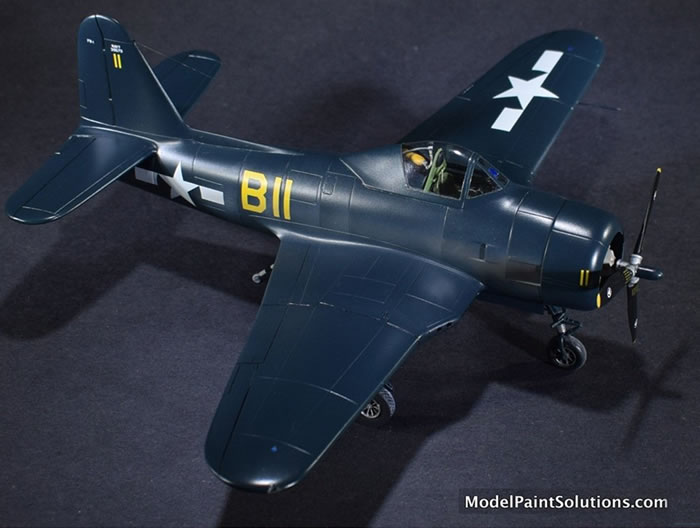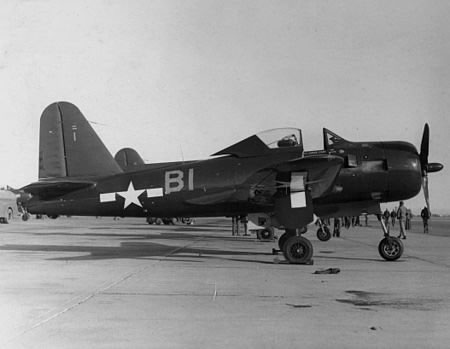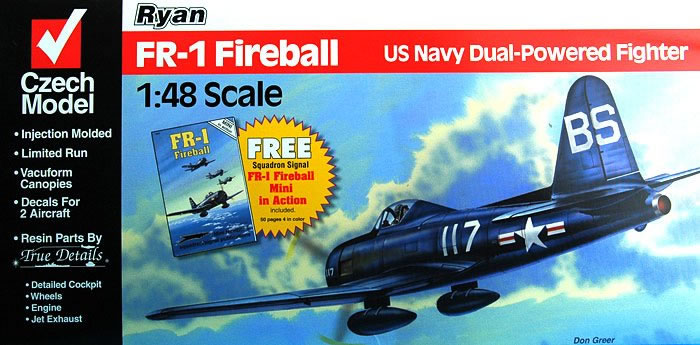Ryan FR Fireball

Czech Model, 1/48 scale
S
u m m a r y : |
Description and Item No.: |
Czech Model Kit No. CM4815 - Ryan FR Fireball |
Scale: |
1/48 |
Review Type: |
Build |
Advantages: |
The kit is simply engineered with crisp, inscribed, surface details and a nice selection of resin parts that includes a cockpit, seat, engine w/ cylinders, wheels, and main wheel wells. |
Disadvantages: |
Being a limited run kit, extra effort is required to get the most out of this model. That translates into a lot of test-fitting/modification of both small and major components. |
Conclusion: |
The Czech Model Fireball is a bit of work but through the process, I learned a few new tricks and polished (literally) a few old ones. |
By John Miller

Hobby Boss' 1/72 P-61A Black Widow is available online from Squadron.com
Czech Model has a reputation for producing detailed kits of lesser-known aircraft. And so it is with their Ryan Fireball: round motor up front, turbojet in the back. I can’t say the Fireball is an attractive airplane but it does have historic appeal. This kit is no cakewalk but it builds into a nice model with a fair amount of effort and patience: lots of patience.
Background
The Ryan FR Fireball was a mixed-power (piston and jet-powered) fighter aircraft designed by Ryan Aeronautical for the United States Navy during World War II. It was the Navy's first aircraft with a jet engine. Only 66 aircraft were built before Japan surrendered in August 1945.
The FR-1 Fireball equipped a single squadron before the end of the war, but did not see combat. The aircraft ultimately proved to lack the structural strength required for operations aboard aircraft carriers and was withdrawn in mid-1947.
Design and Development
Design of the FR-1 began in 1943 to a proposal instigated by Admiral John S. McCain, Sr. for a mixed-powered fighter because early jet engines had sluggish acceleration that was considered unsafe and unsuitable for carrier operations. Ryan received a contract for three XFR-1 prototypes and one static test airframe on 11 February 1943 with the first two prototypes delivered in 14 months. Another contract was placed for 100 aircraft on December 2, 1943 and a later contract on January 31, 1945 increased the total of FR-1s on order to 700.
The XFR-1 was a single-seat, low-wing monoplane with tricycle landing gear. A 1,350-horsepower (1,010 kW) Wright R-1820-72W Cyclone radial engine was mounted in the planes nose and a 1,600 lbf (7,100 N) General Electric I-16 (later redesignated J-31) turbojet was mounted in the rear fuselage. The turbojet, fed by ducts in each wing root, required the wing to be relatively thick in order to accommodate both ducting and the outward-retracting main landing gear. To simplify the fuel system, both engines used the same grade of avgas. Two self-sealing fuel tanks were housed in the fuselage, one of 130 US gallons (490 l; 110 imp gal) and the other of 50 US gallons (190 l; 42 imp gal). The cockpit was positioned just forward of the leading edge of the wing and the pilot was provided with a bubble canopy which gave him excellent visibility. The XFR-1 had the first laminar flow airfoil in a Navy carrier aircraft.

The Fireball was armed with four .50in (12.7 mm) M2 Browning machine guns with 300 rounds per gun. They were mounted in the center section of the wing, immediately outboard of the air intakes for the jet engine. Four 5-inch (127 mm) rockets could be carried under each outer wing panel and two hardpoints were provided under the center section for 1,000 lb (454 kg) bombs or 100 US gal (380 l; 83 imp gal) drop tanks. Armor plates were provided in front and behind the pilot's seat and for the oil cooler.
The first XFR-1 made its first flight on 25 June 1944 without its jet engine, but this was installed shortly afterward. The second prototype first flew on 20 September 1944. Test flights confirmed the results wind tunnel tests: a lack of longitudinal stability due to a miscalculated center of gravity. In addition, the circular rear fuselage of the FR-1 gave less stability than the slab-style fuselage of the Grumman F4F Wildcat that was used as a model for the stability calculations. A new tail with enlarged vertical and horizontal stabilizers was designed and retrofitted to the prototypes. The original Douglas double-slotted flaps proved to be unsatisfactory during flight tests but all three prototypes (and the first 14 production aircraft) were built with them before being replaced with a single-slotted flap.
The first prototype was lost in a crash at NAS China Lake on October 13, 1944. Investigation showed that the wing structure was not strong enough to resist compressibility effects. The problem was addressed by doubling the number of rivets in the outer wing panels. The second prototype crashed on 25 March 1945 when the pilot failed to recover from a dive from 35,000 feet (10,670 m), probably also due to compressibility effects. The third prototype crashed on 5 April when the canopy blew off during a high-speed pass over Lindbergh Field.
Operational testing by the Naval Air Test Center at Naval Air Station Patuxent River that included carrier acceptability tests revealed additional problems. The piston engine tended to overheat until electrically operated cowl flaps were installed, the catapult hooks had to be moved and the nosewheel oleo shock strut lengthened by 3 inches (76 mm). Carrier suitability tests began aboard the escort carrier Charger in early January 1945. The aircraft successfully made five catapult takeoffs using the piston engine as well as three takeoffs using both engines. No problems were reported when landing aboard the carrier.

The FR-1 Fireball was further developed into the XFR-2 which utilized a 1,425 hp (1,063 kW) Wright R-1820-74W in place of the -72W. One single airframe was converted to this configuration. No prototypes were built for the next proposed variant, the FR-3, which would have used a General Electric I-20 turbojet. Both of these projects were canceled with the end of the war. The fastest Fireball, the XFR-4, had a Westinghouse J34 turbojet and was approximately 100 mph (161 km/h) faster than the FR-1. The turbojet's air intakes were moved from the wing roots to the fuselage in front of the wing. Electrically powered doors covered intakes in order to lessen drag of open intakes when the aircraft was flying on only its piston engine. The Fireball's fuselage was lengthened by 8 inches (203 mm) to accommodate the larger engine and the leading edge extension of the wing root that housed the air intakes was also removed. The XFR-4 was intended to serve as a test bed for the turbojet installation on the XF2R-1 Dark Shark: the final variant re-engined with a General Electric XT31-GE-2 turboprop. Only one prototype was built.
On 2 December 1943, orders for 100 production FR-1s were placed, with a follow-up order of 1,000 additional fighters in January 1945. All of the contracts were contingent on the aircraft successfully completing carrier trials. Only 66 Fireballs were completed by November 1945 as orders for 1,044 FR-1s were canceled on VJ Day.
Operational History
One squadron, VF-66, received its first Fireballs in March 1945, but they never saw combat. On May 1, three of the squadron's aircraft were craned aboard the carrier Ranger to attempt to qualify seven pilots, but two of the fighters were damaged while landing. One missed the arresting gear and hit the crash barrier while the other aircraft's nose gear collapsed. The following month the pilots qualified and were on pre-embarkation leave when the Japanese surrendered. The squadron was decommissioned on October 18, with all pilots and aircraft transferred to VF-41.
On November 6, 1945, a Fireball of VF-41 became the first aircraft to land under jet power on an aircraft carrier, albeit without prior planning. After the radial engine of an FR-1 failed on final approach to the escort carrier Wake Island, the pilot managed to start the jet engine and land, barely catching the last arrestor wire before hitting the ship's crash barrier. The squadron was attempting to qualify its pilots for carrier operations during this time, but only 14 of its 22 pilots made the six required takeoffs and landings. A number of accidents occurred when the nose gear failed on landing, but the pilots were at least partly responsible as they were slamming the nose gear onto the deck after landing on the main gear.
The squadron qualified on the escort carrier Bairoko in March 1946, but nose gear problems persisted and cut the cruise short. Ryan installed a steel fork for the nosewheel, but inspections also revealed evidence of partial wing failures so the aircraft was limited to maneuvers not to exceed 5G’s. VF-41 suffered three fatal accidents in 1946 before being redesignated as VF-1E on 15 November 1946. One Ensign collided with the target banner during gunnery practice and spun into the water. A few months later, the squadron commander was performing a barrel roll when his wing broke off and he struck another Fireball, killing both pilots.
VF-1E conducted carrier qualification in March 1947 aboard the escort carrier Badoeng Strait and only eight pilots successfully qualified, not least because the FR-1s were proving to be too fragile to endure repeated carrier landings. During one brief deployment in June aboard Rendova, one aircraft broke in two during a hard landing. Subsequent inspections of the squadron's aircraft showed signs of structural failure and all the Fireballs were withdrawn by 1 August 1947.
After the withdrawal of the type from service, except for a few examples retained for modifications and testing, the FR-1s were scrapped.
Variants
-
XFR-1 -
Military designation of the Prototype Model 28 aircraft: three built.
-
FR-1 Fireball -
Single-seat fighter aircraft: 66 built.
-
FR-2 -
Re-engined with a Wright R-1820-74W: one aircraft modified.
-
FR-3 -
Proposed variant with a General Electric I-20 replacing earlier jet engine: never built.
-
XFR-4 -
Variant with Westinghouse J34: one built.
(Edited from Wikipedia)
This build was out of the box but for a few exceptions. The kit’s resin cockpit was augmented with a PE seat (Lion’s Roar) and color, PE belts (Eduard). The nicely detailed main instrument panel was further detailed by the addition of instrument faces and placards from the spares book.

As the instructions suggest, I placed a sizeable amount of lead in the nose, as this model really desires to sit on its arse when assembled. More on that later…
The nicely detailed, resin wheel wells required a fair amount of modification with a tool of persuasion (read rasp file) in order to fit between the single piece full-span, lower wing and upper left and right wing halves.
The fit of the resin nose wheel well within the fuselage and a slot provided in the lower wing is not a strong point of the kit. Fitting the nose well required a fair amount of modification (read tool of persuasion again) and repeated test fitting.

Next in-line was the round motor (sorry). Here the kit really shines as the resin engine case and cylinders are nicely cast and respond well to additional detailing with lead wire, painting, and oil washes.
The single-piece canopy required a fair amount of modification, filling, and blending to get a passable fit. This was especially true around the front windscreen.

With the model largely assembled a few simple tests confirmed it was going to be a tail-sitter: decidedly so.
Fortunately, I had one trick up my sleeve in the form of the arrester hook. More later…
The canopy, previously dipped in Future Floor Wax (now called “Pledge Revive It Floor Wax”), was masked and the model prepared for primer and paint: my favorite part.
The model was primed with Vallejo White Primer, shot neat at 15psi with a 0.4mm tip. When dry, the primer was gently wet-buffed smooth and the model made ready for painting.
I built this Fireball in 2008/9 when LifeColor (LC) was my go-to acrylic paint. LifeColor is a good paint made better by addressing two issues common to the brand: Tip-Dry and Fragile Finish. Fortunately, both of these issues are easily remedied by diluting the paint sufficiently thin, including a wetting agent like Liquitex Flow Aid (to decease Tip-Dry), and a little Future floor wax (to strengthen the finish). The Fireball was shot with LifeColor Gloss Sea Blue (#UA047) that had been lightened with 5% LC White. In preparation for decals, the model was shot with Future (“Pledge Revive It Floor Wax”) and allowed to dry 24 hours.
The kit decals were applied with Micro-Set and –Sol followed by another coat of Future in preparation for a pin wash with enamel panel liner.
Spraying the Exhaust Stains
Reference pictures of Fireballs in service often show pronounced exhaust staining along the sides of the fuselage. Moreover, the pattern of the staining appears to have been affected by the underlying panels.
To replicate the exhaust staining, the sides of the fuselage were first shot with LC White to which a few drops of LC Tan had been added. While this was being sprayed (moving from the nose to the rudder), Post-It notes were intermittently applied along the panel lines to provide the stepped, panel affect. Depth was added to the White-Tan “stain” by shooting a mix of LC Dark Brown/Black along its length using Post-It notes again as described above. A final shoot of LC Black (with a few drops of LC Green added) right at the opening of the exhaust completed the exhaust stain.
At this point in the build, the canopy masks were removed, and the landing gear, gear doors, prop etc (finished concomitantly with the airframe) were added, mostly with thick CA glue.
The moment of truth was at hand, I carefully set the model on my bench and carefully watched it go… plunk—arse first. Oh yea, I love modeling. Fortunately, by holding the model nose-down on the bench while gluing the tail hook in place, I was able to negotiate an amicable agreement with my Fireball, which now begrudgingly sits on its nose gear in my display cabinet. Save!
The Czech Model Fireball is a bit of work but through the process, I learned a few new tricks and polished (literally) a few old ones. One trick of lasting value is to spend more time assessing the center of gravity of any “trike gear” aircraft model while it’s still in the build stage. I don’t like arse-sitters.
--John
For more painting details from this build visit Modelpaintsolutions.com.
Text and Images Copyright © 2019 by Model Paint Solutions
Page Created 20 June, 2019
Last updated
20 June, 2019
Back to HyperScale Main Page
Back to Reviews Page

|
Home
| What's New |
Features |
Gallery |
Reviews |
Reference |
Forum |
Search